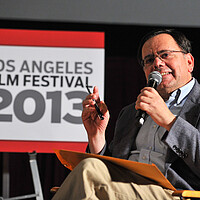Francis Ford Coppola spent $125 million on ‘Megalopolis.’ How is it?
Francis Ford Coppola’s long-awaited “Megalopolis,” set in the futuristic city of New Rome, is the movie he’s been wanting to make for 40 years. Now that he’s finally written and directed it, what in tarnation has he wrought?
The narrative, such as it is, loosely derives from the Catiline conspiracy of 63 B.C., when the aristocrat Lucius Sergius Catilina failed in his attempt to overthrow the Roman consul Marcus Tullius Cicero.
In Coppola’s version, Catilina has become Cesar Catilina (Adam Driver), a visionary Nobel Prize-winning scientist-architect obsessed with rebuilding the urban blighted New Rome as a sustainable utopia. His primary building block is “megadon,” a substance he created that allows him to control space and time. His nemesis is Franklyn Cicero (Giancarlo Esposito), New Rome’s mayor, a status quo kind of guy. Ostensibly it’s a tradition versus progress fable.
In actuality, it’s a movie furiously, perhaps intentionally, at odds with itself. Coppola’s Catilina may represent a resplendent avatar of a utopian future – a cross between Iron Man and Howard Roark, the uncompromising architect from Ayn Rand’s “The Fountainhead.” But he’s also a self-obsessed megalomaniac who has possibly poisoned his wife. His greatest goal, aside from saving mankind, is to stop time – i.e., cheat death.
Despite the film’s bias against Cicero, his embattled resistance to Catilina doesn’t appear altogether baseless or unreasonable. After all, the New Rome he presides over – which at times resembles one big toga party – doesn’t seem a whole lot more dystopian than the supposedly glorious city Catilina envisions.
One of the film’s central deficiencies is that Coppola never convincingly shows us those glories. It’s a visionary movie without a vision. Or perhaps there are simply too many visions, all elbowing for center stage in Coppola’s rowdy bacchanal.
At times the film resembles a cross between “Blade Runner” and “Caligula.” Maybe it will become this era’s head-trip movie the way “2001” and “Fantasia” functioned for earlier generations.
But it’s difficult to bliss out on a movie so clamorous. Coppola, a past master at directing actors, allows his performers – who include Dustin Hoffman, Jon Voight, Aubrey Plaza, and Nathalie Emmanuel – to shamelessly ham it up. Laurence Fishburne, playing the film’s ostensible fount of wisdom, intones weighty lines like “Such are the difficulties of the human heart.” Catilina recites Hamlet’s “To be, or not to be” soliloquy. We’re treated to clunkily staged orgies, prancing vestal virgins, glancing references to the rise of Hitler and Mussolini – all in the service, I suppose, of the thesis that empires fall to fascism through moral decay.
Is Coppola drawing some sort of analogy between the world we live in and New Rome? And is the genius-visionary Cesar Catilina, with all his torments and aberrations, somehow meant to be a stand-in for Coppola himself? Coppola self-financed this $125 million dollar movie because he wanted to exert complete artistic control. Alas, what ran through my mind while watching is: Be careful what you wish for.
And yet, to my surprise, I did take away something that has stayed with me and even moved me. Years ago, at the time of “One From the Heart,” I wrote of Coppola: “He’s cast himself as an innovator – a visionary – and yet his great work has been solidly grounded in the old-fashioned narrative tradition.” In “Megalopolis” the director of two of the finest films ever made – the first two “Godfather” movies – is still miscasting himself as an innovator.
But innovation isn’t everything. Setting aside my reservations, I choose to read the film as Coppola’s encoded meditation on his own mortality. Like his flawed hero Catilina, he wants to stop time. At 85 years old, having not directed a film in over a decade, he has at last made his passion project. I wish I liked “Megalopolis” much more than I did, but, in the end, that may not really matter. A great artist is entitled to his grand follies.
Peter Rainer is the Monitor’s film critic. “Megalopolis” is rated R for sexual content, nudity, drug use, language and some violence.






